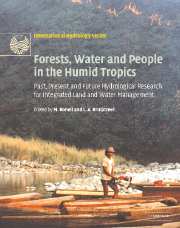 Forests, Water and People in the Humid Tropics
Forests, Water and People in the Humid Tropics Published online by Cambridge University Press: 12 January 2010
Management problems of water-source areas in developing countries show, within my experience, a characteristic pattern. For familiar ecological reasons, streamflow from forested hills supports the economic development of populations of the valleys and plains below. The protection of water source areas is therefore accepted, in principle, as necessary to national development. Such protection of remote areas is difficult to fund and to staff. The rapid growth of tropical populations has, however, resulted in large-scale invasion and destruction of upper-watershed forests by subsistence cultivators and graziers. Deterioration of streamflow regulation has become an all-too-familiar result, with regular flow replaced by flood flows and dwindling dry-season supply.
Authority resides in cities, but administration strong enough to protect these watershed forests must be resident in the hills. For the administrator, a posting to the remote hills is effectively a banishment to a life far from schools and other amenities as well as from opportunities for recognition and promotion. Thus although Forest Departments maintain their protective patrols by devoted staff, they are, in many countries, inadequately supported by the administration of the law.
Technical reports by hydrologists and land-use specialists, after making systematic surveys paid for by governments, have spelled out the critical importance of watershed protection, but the necessary following action has been neglected in at least a score of countries that I have been privileged to study.
To save this book to your Kindle, first ensure no-reply@cambridge.org is added to your Approved Personal Document E-mail List under your Personal Document Settings on the Manage Your Content and Devices page of your Amazon account. Then enter the ‘name’ part of your Kindle email address below. Find out more about saving to your Kindle.
Note you can select to save to either the @free.kindle.com or @kindle.com variations. ‘@free.kindle.com’ emails are free but can only be saved to your device when it is connected to wi-fi. ‘@kindle.com’ emails can be delivered even when you are not connected to wi-fi, but note that service fees apply.
Find out more about the Kindle Personal Document Service.
To save content items to your account, please confirm that you agree to abide by our usage policies. If this is the first time you use this feature, you will be asked to authorise Cambridge Core to connect with your account. Find out more about saving content to Dropbox.
To save content items to your account, please confirm that you agree to abide by our usage policies. If this is the first time you use this feature, you will be asked to authorise Cambridge Core to connect with your account. Find out more about saving content to Google Drive.